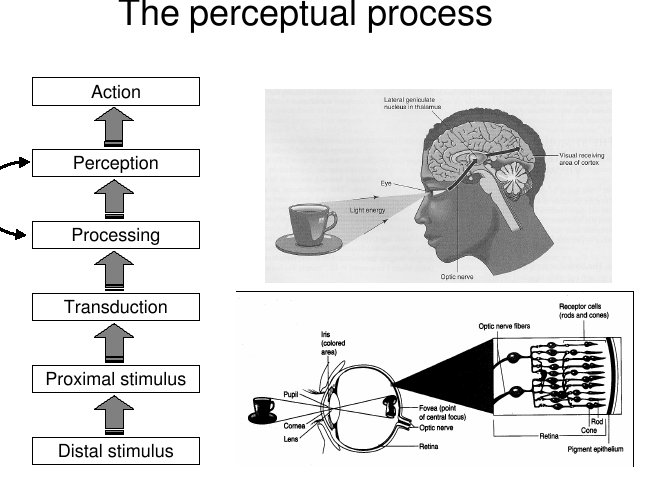Structure of the Neuron
*
Dendrites
Filaments
that receive information from other neurons, receptors, etc.
*
Soma (cell body)
Contains nucleus of the cell
Manufactures enzymes and molecules to maintain cell life.
NOTE: In
the PNS, a group of cell bodies and dendrites are called ganglion and
in the CNS, it would be called a nucleus.
*
Axon
Filament
that transmits information to the dendrites or soma of other neurons.
NOTE: In
the PNS, a group of axons is called a nerve and in the CNS it is called
a tract.
*
Myelin Sheath
Insulation on axon to improve speed of transmission.
Also insulates axon from activity of other neurons.
Other manufacturing, nurturing, and clean-up tasks
*
Axon Terminal
Where neurotransmitters are stored.
How Neurons Fire
*
Electrochemical process
Propagation of impulse within neuron (electrical).
Transmission of impulse between neurons (chemical).
*
Resting Potential
Neuron at rest
Not firing.
Stable,
negative charge inside neuron relative to outside (- 70 mV).
(Hyperpolarization)
Sodium (Na+) outside the neuron.
*
Action Potential
Neuron
receives sufficient stimulation from receptor, other neurons, etc..
Na+ ions rush in.
Interior
of axon becomes positive relative to the outside (+ 40 mV).
(Depolarization)
This
release of energy passes down the axon and is the firing of the neuron.
* Once neuron fires, resting potential returns.
·
All or None Law
* Once neuron fires, the impulse moves down the axon at the same intensity.
No stopping it.
·
Impulse frequency
* While there are differences in speed of
transmission between neurons, increase in neuron stimulation doesn’t
cause stronger impulse. Speed and electrical change remains the same
regardless of intensity.
* Stronger stimulation leads to more frequent firing of the neuron or more neurons activated.
·
Absolute Refractory Period
* Brief period of time after firing when neuron won’t fire no matter how much stimulation given.
As brief
as 1/1000 of a second. HOWEVER, means a limit as to how many times
neuron can fire per second (the maximum is 500-600 times/second).
·
Think of neuron like a toilet that works well
* Information flows in 1 direction (out to the sewage!)
* It is all or none - the toilet doesn't have "half flush" days
* There is a period of time that, no matter how much you jiggle the handle, no flushing will occur
How Neurons Send Messages
*
Synapse
Small gap
or cleft between the axon of one neuron and the dendrite of another.
*
Axon terminal
Contains synaptic vesicles
*
Neurotransmitters
Chemical substances released by synaptic vesicles.
Taken up by the axon of the receiving neuron
Work in Lock and Key fashion
Inhibitory (tells the neuron NOT to fire) or Excitatory (tells the
neuron to fire)
If gets
more excitatory information than inhibitory, neuron will fire, if more
inhibitory than excitatory, will not fire.
A neuron AT REST will occasionally spontaneously fire
Excitatory information - causes depolarization (an increase in neural firing)
Inhibitory information - causes hyperpolarization (a decrease in neural firing)
Neurochemicals
* Selected neurotransmitters
o
Acetylcholine
+ motor, learning memory, contract muscles, REM sleep
+ Alzheimers, black widow spider bite
o
Dopamine
+ motor, attention, emotions
+ Parkinson’s, schizophrenia
o
Norepinephrine
+ regulation of arousal, eating and sleeping
+ manic, depression
o
Serotonin
+ arousal, sleep, learning, mood, aggression, appetite
+ depression
o
Endorphins
+ Pain reduction, pleasure
+ possibly related to "runner’s high"
PSYCHOPHYSICS
* The relationship between the stimulus (what is
actually in the environment) and perception (what we experience)
* Quantifying the mind
Absolute Threshold
* Minimum amount of energy necessary to detect a stimulus 50% of the time
* This is the lower limit of an organism’s
sensitivity, the point at which the organism is just noticing something
Difference Threshold
* Minimum amount of energy necessary to detect a change in a stimulus 50% of the time
* This is when an organism can recognize that something is different from something else.
Sensitivity
* Inverse of threshold – (1/threshold)
* If a person is very sensitive to something, they
have a low threshold. If a person has a low sensitivity, they have a
high threshold.
Why measure threshold? – Threshold is not rigid – it varies
*
See differences within a sense
o For example,
we are more sensitive to yellow light than we are to blue light. If you
ask someone to make a yellow light and a blue light equal in perceived
brightness (perception), you would find that the actual intensity of
the yellow light is less than the actual intensity of the blue light
(stimulus).
o We are also more sensitive to salt than we are to sugar.
*
See differences between senses
o For example,
we are more sensitive to changes in pitch and light than we are to
changes in smell and taste.
*
See differences between individuals
o For example,
individuals have different preferences for spicy foods. Some people can
eat very hot foods and not even blink an eye and other individuals
would be in agony. Supertasters are more sensitive to bitter
*
See differences within an individual
o For example,
our sensitivity can change. We are more sensitive to sounds in the
morning than in the evening.
o We can adapt
to odors. If you put cologne or perfume on, you will smell it at first,
but over time, we no longer can smell it.
How do we measure threshold?
o
The Classic Methods (Fechner)
* Participants are given stimuli both just below and just above threshold
o Look for
crossover point – when person says yes instead of no (when using
ascending trials) OR when person says no instead of yes (when using
descending trials)
1. Method of Adjustment
* The participant adjust the intensity of the
stimulus until they can either just detect or just not detect a stimulus
* Least accurate, but the fastest
* Example – Person turns a knob until they can just sense tone or just not sense a tone
* Example – using the contrast button or knob on your computer
2. Method of Limits
* The participant is given discrete steps in order controlled by the experimenter
* Example – eye test
* Example, have 8 glasses of water, each with 2 cups
of water and different levels of sugar. Glass 1 has no sugar, glass 2
has ¼ teaspoon (t) of sugar, glass 3 has ½ t of sugar,
glass 4 has 1 t of sugar, etc. and glass 8 has 2 t of sugar.
* Present glasses to individual, starting at
different points going from until participant can just taste or not
taste sugar. Y means can taste, N means can’t taste.
Trial 1Trial 2Trial 3Trial 4
Glass 1N
Glass 2NNN
Glass 3NNNN
Glass 4YYNY
Glass 5YYY
Glass 6YY
Glass 7Y
Glass 8Y
*
Why go in both directions (ascending and descending)? To prevent and cancel out the following errors
o
Error of habituation
– individuals who keep responding the same way, work on principle that
the stimulus is going to be the same as the last stimulus
+ want to be absolutely sure tasted sugar before responding yes
o
Error of anticipation
– individuals who jump the gun and change their responses quickly, work
on principle that the stimulus is going to be different from the last
stimulus
+ as soon as possibility that might has tasted sugar, say yes
3. Method of Constant Stimuli
* The stimuli are randomly presented a number of times
* Slowest, but most accurate
* Example, instead of giving above glasses of water in order, present them to the participant randomly.
* Hearing test
Weber’s Law (just noticeable difference)
• Relates size of JND to size of the standard.
• Difference threshold gets larger as standard gets larger but ratio remains the same
• Delta S/S = k
– Delta S = difference
– S = magnitude of standard stimulus
– k = Weber fraction
• Smaller the fraction, better can discriminate
Common Weber Fractions (Delta S/S)
• Light intensity 0.079, Sound Intensity 0.048, Lifted Weight 0.022, Line Length 0.029, Taste 0.083, Electric Shock 0.013
Fechner’s formula
• Assume all JND are psychologically equal (60-61 change is same as 300-305 change)
• P=k log S
– Perception, constant, intensity
– Log – the power to which 10 must be raised to equal that number (log 10 = 1, log 100 = 2)
• Say have k = 1
• P = 1 * 10
• P = 1
• What if want P = 2 (perc as 2x as powerful)?
• S = 100
• Works at midrange. See in use calculating decibels



